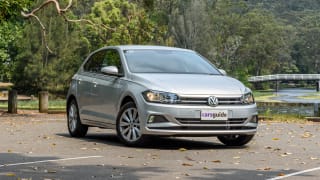A decade ago, no Yaris had the technology or ability to directly compete against super-parsimonious Euro supermini diesels like the Volkswagen Polo TDI or Ford Fiesta Econetic (remember that?).
Now that diesels have fallen from grace, it’s the hybrids that are stepping up, with the Yaris representing a modern-day evolution. That the Toyota supermini has undergone its own revolution for incarnation number four since the Echo surfaced in late 1999 should not be underestimated. Slightly shorter and lower than before, but sitting on a wheelbase that’s some 40mm longer, it switches to the Toyota New Global Architecture with a stronger body, lower seating and a reduced centre of gravity, promising improved packaging as well as dramatically greater safety and dynamic capabilities.
In this context, the $29,020 before on-road costs (ORC) that Toyota charges for the SX Hybrid takes some of the sting out of the series’ unbelievable circa- $7K price hikes when the new-gen version debuted last year – particularly when you realise that there are no other similarly-sized supermini hybrid rivals. In fact, the next cheapest non-Toyota hybrid is the Hyundai Ioniq Hybrid Elite for $6000 more.
But there is a very conspicuous pricing anomaly here.
The company will sell you the larger and more powerful Corolla Ascent Sport Hybrid from $27,395 (before ORC), as well as the longer and roomier Yaris Cross GX 2WD Hybrid light SUV from $28,990 (before ORC), which seems odd until you realise that there is no base Yaris Ascent Sport Hybrid currently available. If there were, we’d assume the $2000 premium that’s charged for adding electrification should apply to the regular entry-level petrol version, meaning that non-existent entity would cost $25,630.
Is Toyota playing games with its faithful-to-a-fault customers?
At least the Yaris is well equipped.
On the safety front, all grades include class-first front-row centre airbags to help protect lateral occupant collision in a side impact, autonomous emergency braking (AEB) with pedestrian and cyclist detection, secondary collision braking, adaptive cruise control (but without the full stop/go tech offered elsewhere, disappointingly), auto high beam, lane-keep assist, cornering assist, road-sign recognition and a reverse camera.
There’s also a 7.0-inch touchscreen featuring Apple CarPlay/Android Auto, Bluetooth audio and telephony compatibility, digital radio and voice recognition, a 4.2-inch multi-information display, tilt and reach steering adjustability, electric windows, power folding mirrors and air-conditioning. Stepping up to our SX ushers in digital instrumentation, climate control, keyless entry/start, satellite navigation, more premium trim including a leather-clad steering wheel, LED lights, privacy glass and 15-inch alloy wheels.

Most of that Yaris SX gear, by the way, isn’t on the base Corolla Ascent Sport Hybrid or Yaris Cross GX 2WD Hybrid, partly redressing the price gap.
For a blind-spot monitor and front and rear parking sensors you’ll need to find another $3080 for the flagship ZR, which also adds a head-up display, more bolstered front seats, racier upholstery, a spoiler and 16-inch alloys. It’s too bad Toyota doesn’t make this grade’s safety gear available as a separate low-cost option pack on lower-line variants. And no amount of cash will get you a wireless smartphone charger. What is this? 2019?

The Yaris SX for 2021 is available in the following colours: Cherry Blossom (pink), Glacier White, Ebony Black, Crystal Pearl, Silver Pearl, Atomic Rush (maroon), Scarlet (purple), Lunar Blue, Bronx Bronze, Coral Rose, Electric Blue and Electric Green. Premium paint adds $500.
Inevitably, the SX Hybrid’s biggest ace up its sleeve is under the bonnet and back seats, thanks to an all-new 67kW/120Nm 1.5-litre three-cylinder petrol engine paired with a 59kW/141Nm electric motor and lithium-ion battery. Not only does the combined power total rise to 85kW, it offers startling economy of just 3.3L/100km, to make it the most frugal Toyota ever sold in Australia.
So, yes. The Yaris is far from cheap. But it is also generations ahead of the dated and unrefined model of the same name it replaces. And – Corolla and Yaris Cross aside – it is the least expensive hybrid you can buy right now.
Until Toyota decides to introduce a Yaris Ascent Sport Hybrid, that is. If that happens at all. That would make the brand’s tiniest petrol-electric model a steal.




















